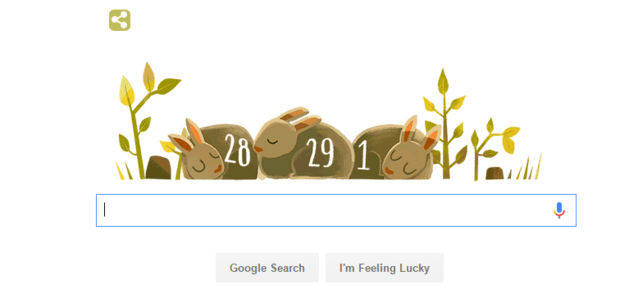advertisement
Google marks the leap year with a doodle
2016 being a leap year, Google has choosen to mark this day with a Google Doodle a day that comes…

2016 being a leap year, Google has choosen to mark this day with a Google Doodle a day that comes after every four years.
In this doodle, a rabbit with the number 29 that leaps between two other rabbits marked 28 and 1 marking Leap Year 2016, a visit to the search engine’s homepage revealed on Monday, February 29.
Google said Feb. 29 was very special as this happened only every four years to keep our calendar in sync with the rotation of the Earth around the sun.
advertisement
“Without Leap Day, we’d be out of sync by about six hours per year,” Google said in explaining the doodle by Olivia Huynh.
But Google also noted Leap Day would not occur in a year divisible by 100. “If you were around in 1900, you would have missed out on the magic of February 29,” it said.
So how did the leap year come to be? The Roman calendar did have 355 days with an extra 22-day month every two years, until Julius Caesar became emperor and ordered his astronomer Sosigenes to devise a better system in the 1st Century.
advertisement
Sosigenes decided on a 365-day year with an extra day every four years to incorporate the extra hours, and so February 29th was born.
As an earth year is not exactly 365.25 days long Pope Gregory XIII’s astronomers decided to lose three days every 400 years when they introduced the Gregorian calendar in 1582.
The maths has worked ever since but the system will need to be rethought in about 10,000 years’ time.
advertisement
However, the years 1700, 1800 and 1900 were not leap years this is because there’s a leap year every year that is divisible by four, except for years that are both divisible by 100 and not divisible by 400.
The added rule about centuries (versus just every four years) was an additional fix to make up for the fact that an extra day every four years is too much of a correction.